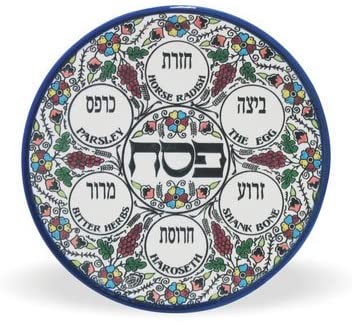
Passover Symbolic Foods
Share
Symbolic foods

1. Zeroa (shankbone)
2. Beitza (roasted hard-boiled egg)
3. Maror /Chazeret (horseradish)
4. Maror /Chazeret (onion)
5. Charoset
6. Karpas (parsley)
Karpas can be any vegetable for which the blessing over fruit of the earth is recited. Parsley or another green leafy vegetable is traditionally used. Jews of Eastern European descent sometimes use potatoes as it was the closest to a green vegetable that was often available during Passover.
For maror, bitter herbs, use horseradish root or a bitter lettuce. Put enough on the seder plate for everyone as the maror will be eaten during the seder.
The zro'a, shank bone, is a reminder of the Passover sacrifice. According to the Talmud vegetarians may substitute a raw beet, which also bleeds when cut. The zro'a is not eaten at the seder.
The beitzah is a roasted hard-boiled egg. It is included on the seder plate in remembrance of the holiday sacrifice offered at the Temple. It can also be seen as a symbol of creation and the cycle of life and death, as eggs are eaten by mourners after a funeral. The beitzah on the seder plate is not eaten or used during the seder.
The charoset is a mixture of wine, fruits, nuts, honey and spices that symbolizes the mortar with which the Israelites made bricks during slavery. Askenazi charoset is usually made of apples, nuts, sweet wine, honey or sugar and cinnamon. Sephardic charoset recipes contain dates, figs, apricots almonds and less or no wine. Make plenty of charoset, as it is always a favorite.
The sixth optional item on the seder plate is chazeret, a second bitter herb, which is added to the Hillel sandwich. You can use romaine lettuce or prepared horseradish for chazeret.
